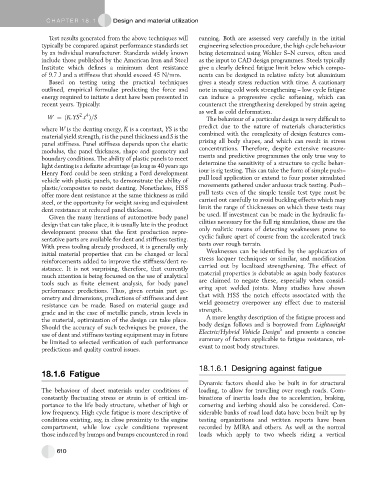Page 599 - Automotive Engineering Powertrain Chassis System and Vehicle Body
P. 599
CHAP TER 1 8. 1 Design and material utilization
Test results generated from the above techniques will running. Both are assessed very carefully in the initial
typically be compared against performance standards set engineering selection procedure, the high cycle behaviour
by an individual manufacturer. Standards widely known being determined using Wohler S–N curves, often used
include those published by the American Iron and Steel as the input to CAD design programmes. Steels typically
Institute which defines a minimum dent resistance give a clearly defined fatigue limit below which compo-
of 9.7 J and a stiffness that should exceed 45 N/mm. nents can be designed in relative safety but aluminium
Based on testing using the practical techniques gives a steady stress reduction with time. A cautionary
outlined, empirical formulae predicting the force and note in using cold work strengthening – low cycle fatigue
energy required to initiate a dent have been presented in can induce a progressive cyclic softening, which can
recent years. Typically: counteract the strengthening developed by strain ageing
as well as cold deformation.
2 4
W ¼ðK:YS :t Þ=S The behaviour of a particular design is very difficult to
predict due to the nature of materials characteristics
where W is the denting energy, K is a constant, YS is the
material yield strength, t is the panel thickness and S is the combined with the complexity of design features com-
panel stiffness. Panel stiffness depends upon the elastic prising all body shapes, and which can result in stress
modulus, the panel thickness, shape and geometry and concentrations. Therefore, despite extensive measure-
boundary conditions. The ability of plastic panels to meet ments and predictive programmes the only true way to
light denting is a definite advantage (as long as 40 years ago determine the sensitivity of a structure to cyclic behav-
Henry Ford could be seen striking a Ford development iour is rig testing. This can take the form of simple push–
vehicle with plastic panels, to demonstrate the ability of pull load application or extend to four poster simulated
plastic/composites to resist denting. Nonetheless, HSS movements gathered under arduous track testing. Push–
offer more dent resistance at the same thickness as mild pull tests even of the simple tensile test type must be
steel, or the opportunity for weight saving and equivalent carried out carefully to avoid buckling effects which may
dent resistance at reduced panel thickness. limit the range of thicknesses on which these tests may
be used. If investment can be made in the hydraulic fa-
Given the many iterations of automotive body panel
design that can take place, it is usually late in the product cilities necessary for the full rig simulation, these are the
development process that the first production repre- only realistic means of detecting weaknesses prone to
sentative parts are available for dent and stiffness testing. cyclic failure apart of course from the accelerated track
With press tooling already produced, it is generally only tests over rough terrain.
initial material properties that can be changed or local Weaknesses can be identified by the application of
reinforcements added to improve the stiffness/dent re- stress lacquer techniques or similar, and modification
sistance. It is not surprising, therefore, that currently carried out by localized strengthening. The effect of
much attention is being focussed on the use of analytical material properties is debatable as again body features
tools such as finite element analysis, for body panel are claimed to negate these, especially when consid-
performance predictions. Thus, given certain part ge- ering spot welded joints. Many studies have shown
ometry and dimensions, predictions of stiffness and dent that with HSS the notch effects associated with the
resistance can be made. Based on material gauge and weld geometry overpower any effect due to material
grade and in the case of metallic panels, strain levels in strength.
the material, optimization of the design can take place. A more lengthy description of the fatigue process and
Should the accuracy of such techniques be proven, the body design follows and is borrowed from Lightweight
5
use of dent and stiffness testing equipment may in future Electric/Hybrid Vehicle Design and presents a concise
be limited to selected verification of such performance summary of factors applicable to fatigue resistance, rel-
predictions and quality control issues. evant to most body structures.
18.1.6.1 Designing against fatigue
18.1.6 Fatigue
Dynamic factors should also be built in for structural
The behaviour of sheet materials under conditions of loading, to allow for travelling over rough roads. Com-
constantly fluctuating stress or strain is of critical im- binations of inertia loads due to acceleration, braking,
portance to the life body structure, whether of high or cornering and kerbing should also be considered. Con-
low frequency. High cycle fatigue is more descriptive of siderable banks of road load data have been built up by
conditions existing, say, in close proximity to the engine testing organizations and written reports have been
compartment, while low cycle conditions represent recorded by MIRA and others. As well as the normal
those induced by humps and bumps encountered in road loads which apply to two wheels riding a vertical
610

